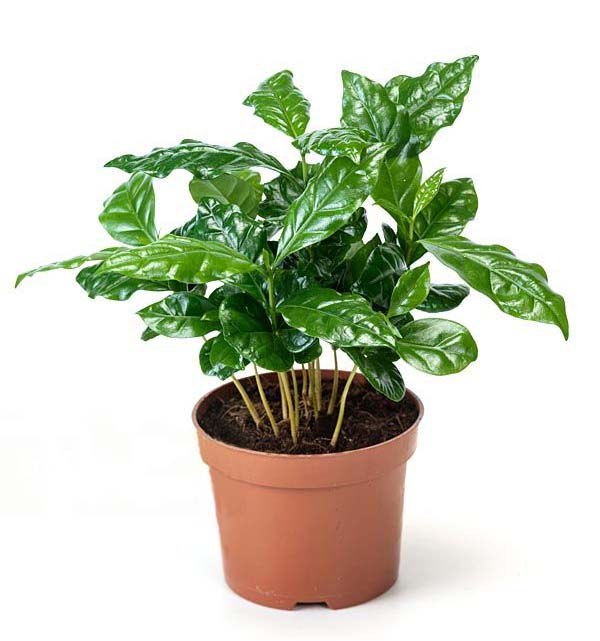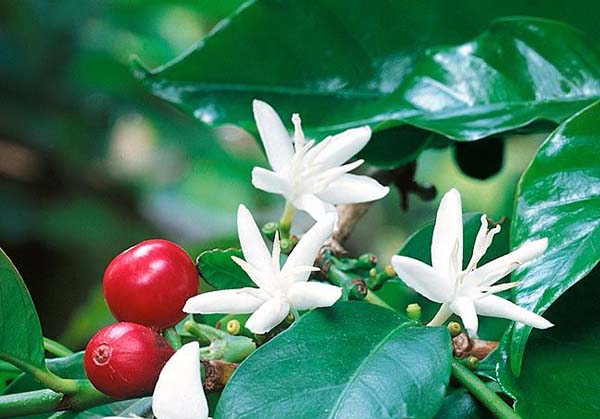Growing Coffee Plant Indoors
Growing coffee at home can be an engaging and achievable endeavor, even for those without a green thumb.
Coffea is a genus of flowering plants in the family Rubiaceae. Coffea species are shrubs or small trees native to tropical and southern Africa and tropical Asia.

There are over 120 species of Coffea, which is grown from seed. The two most popular are Coffea arabica (Arabica) and Coffea canephora (Robusta). Coffea arabica is preferred for its sweeter taste, while Coffea canephora has a higher caffeine content. To ensure successful cultivation of coffee plants, it's essential to understand the care nuances for different coffee tree varieties, such as Canephora and Arabica.
It is an evergreen shrub that has glossy, dark-green leaves with ruffled edges on willowy stems. The leaves can grow up to 6 in/15 cm long and about 2 in/5 cm wide on mature plants. Indoor coffee plants are slow growing, but make attractive houseplants, even when young. Coffea arabica 'Nana' that only grows to about 1 ft/30 cm tall.
The white flowers are highly scented. The fruit takes about nine months to ripen. The trees produce edible red or purple fruits, and it contains two seeds, called "coffee beans.

Coffee Plant Care Tips
Growing coffee at home is easy if you remember that coffee plantations are located on mountain slopes, where there is no stagnant water and the soil is quite dry. It’s also warm and humid there.
Temperature: Coffee trees thrive in a warm climate. For Coffea Arabica, the optimal temperature is (65-75°F/18-24°C), while Coffea Canephora can tolerate higher temperatures. Avoid abrupt temperature fluctuations, especially cold nights.

Light: Coffee plants prefer bright but indirect light. Place the pot near an east or west-facing window to provide ample light without direct sunlight, particularly during the summer months.
Water: Moderate watering is key to success. Allow the soil to dry between waterings, preventing overwatering. Coffee trees dislike waterlogged roots, so ensure proper drainage in the pot. Always use tepid water for watering your houseplants because cold water is a shock to them.
Humidity : Requires moist air (around 50% relative humidity or higher). Leaf drop and brown leaf tips are a symptom of dry air. It's easy to raise the humidity for houseplants with a cool-mist room humidifier. To raise the humidity, use a cool-mist room humidifier for best results.
Soil: Use a light, well-draining soil. The ideal pH range is closer to 6 to 6.5. Potting mix with added perlite or vermiculite provides the necessary root ventilation. Coffee plants prefer acidic soil, so add organic matter, such as sphagnum peat moss.
Fertilization: During the active growth period (spring and summer), fertilize the plant with a general-purpose indoor plant fertilizer every 2-4 weeks. Reduce the frequency during autumn and winter.
Repotting: Young plants benefit from annual repotting, while mature ones should be repotted every two years in the spring. This helps refresh the soil and prevent root overhydration.
Propagation: Coffee trees can be propagated from seeds, but this process takes time. A more efficient method is propagation from cuttings taken from mature plants.
To propagate coffee plant, you can do so from cuttings or air layers, which is a somewhat involved technique where you root branches still attached to the parent plant. The best time to take a cutting is in the early summer. Select a straight shoot that's about 8 to 10 inches long and remove all but a pair of upper leaves. Then, plant the cutting in a small pot of soilless potting mix, and keep the soil slightly moist.
For successful rooting, it is necessary to maintain a temperature of at least (77°F/ 25°C) degrees. Too high a temperature is detrimental to rooting.
When you see that a new pair of leaves appears, the scion can be considered to have successfully rooted.
Common Issues in Home Cultivation: Overwatering leading to root rot is a frequent issue. Additionally, be vigilant against diseases like powdery mildew and spider mites, which can harm your plant.
By following these straightforward guidelines, you can enjoy your own aromatic coffee at home, creating a cozy corner of nature right in your living space.




